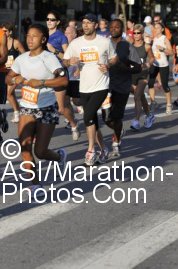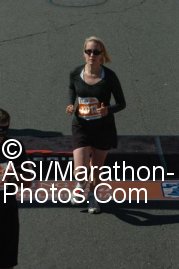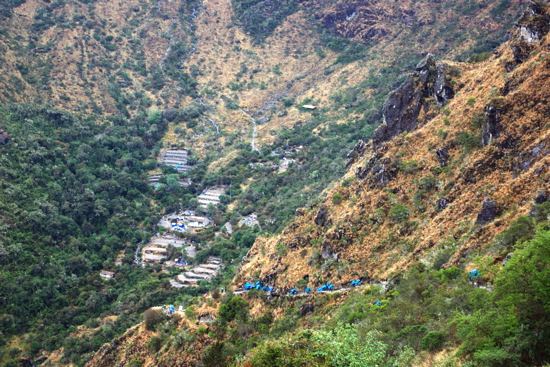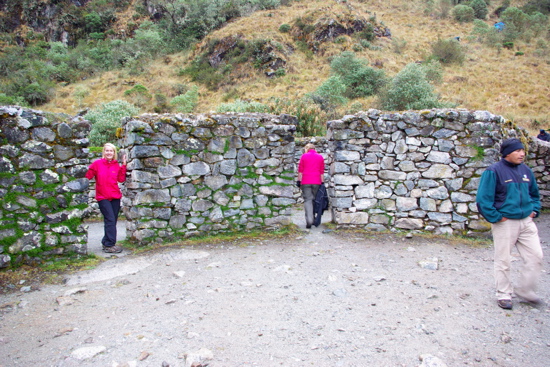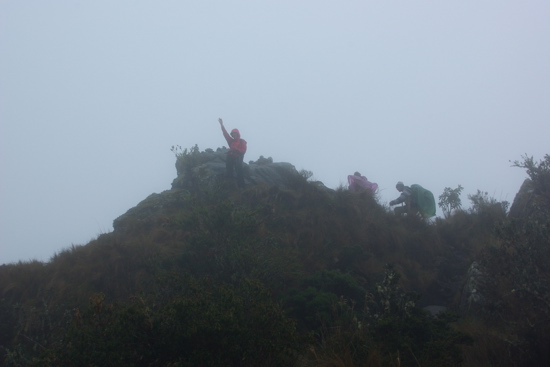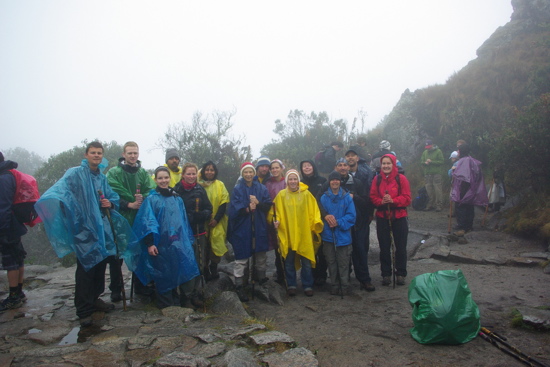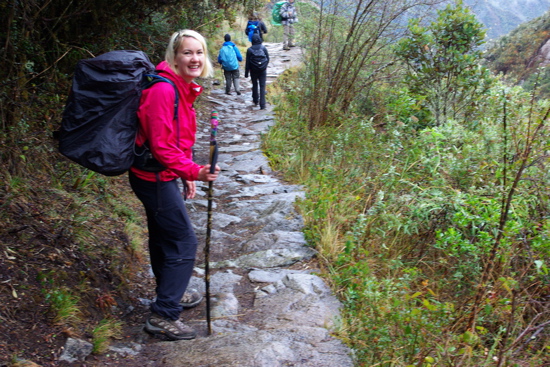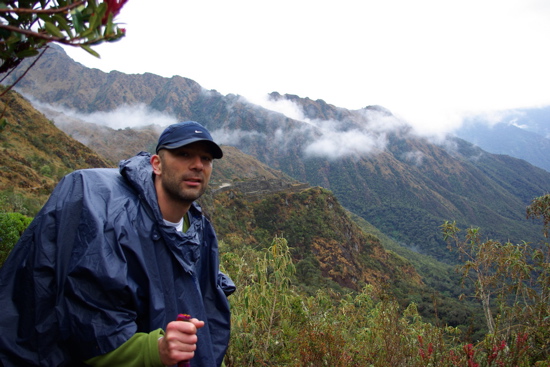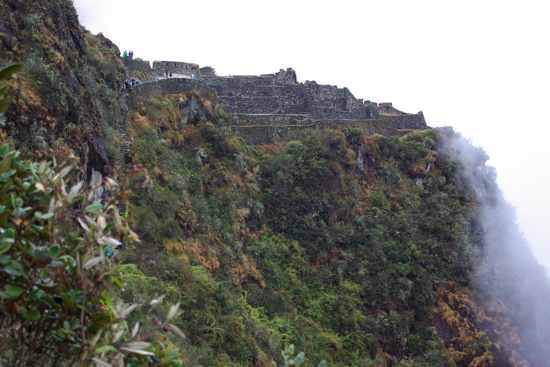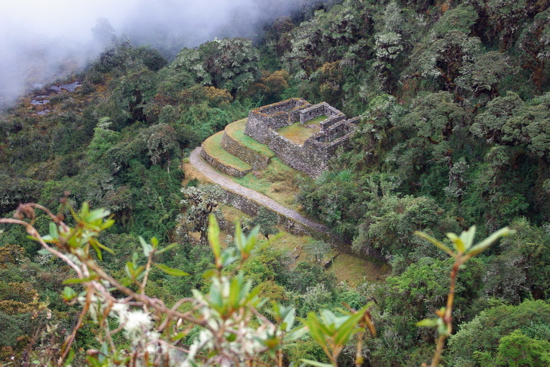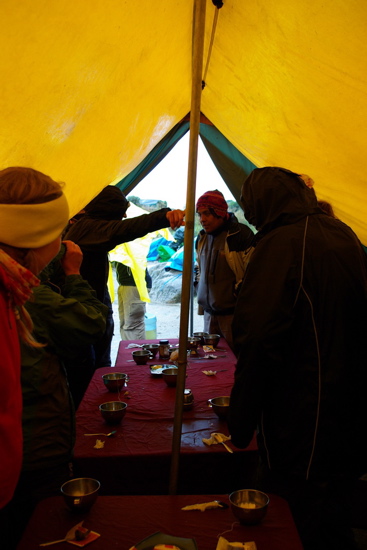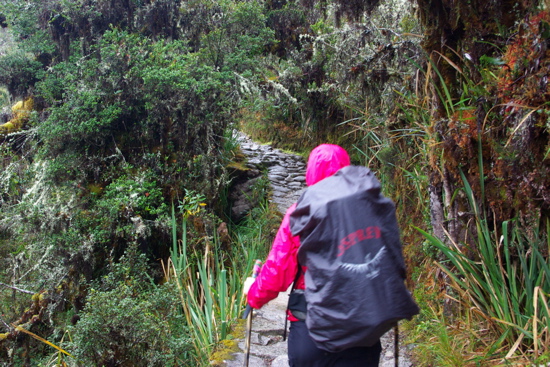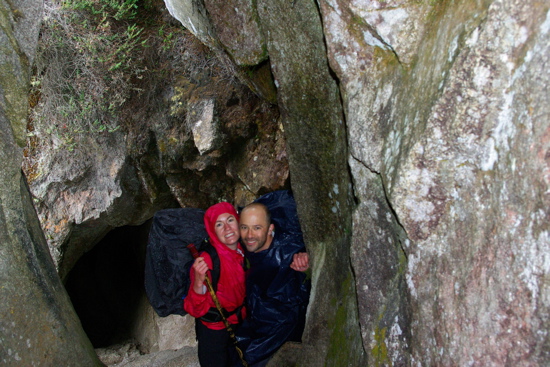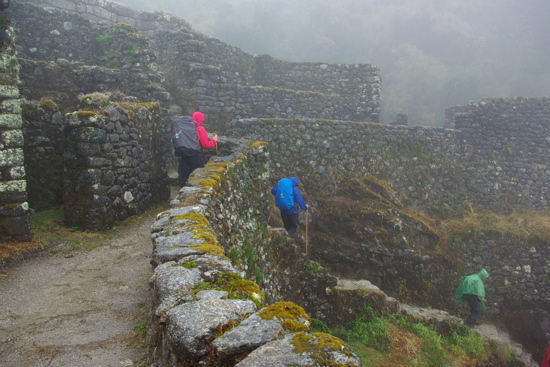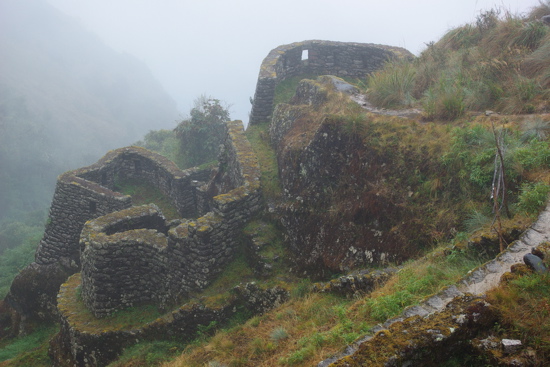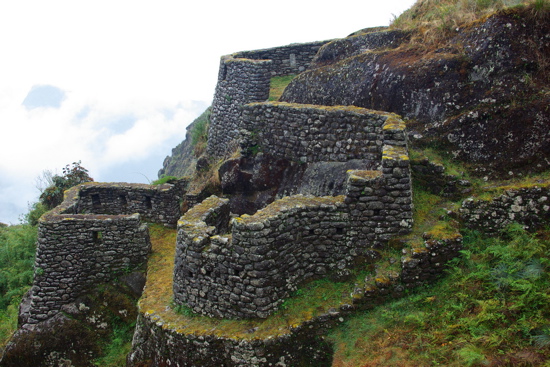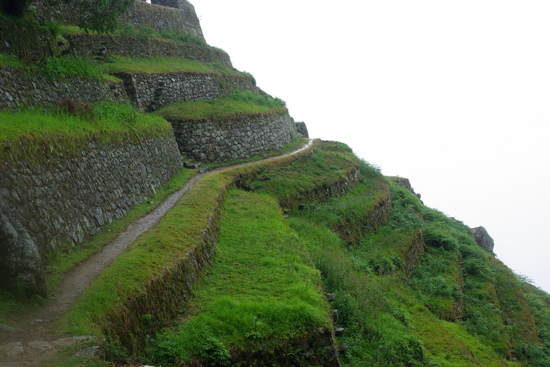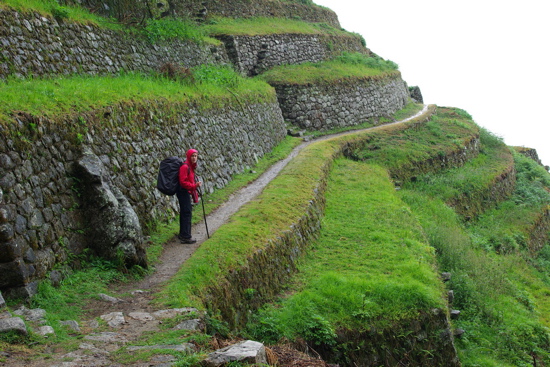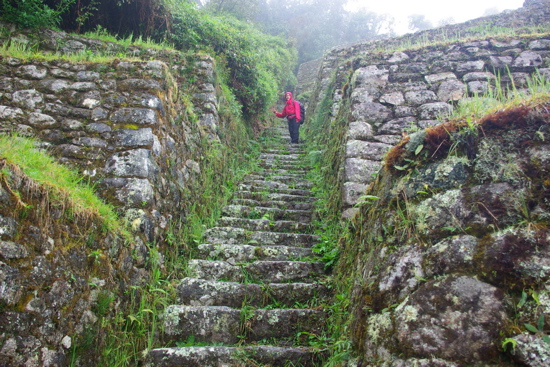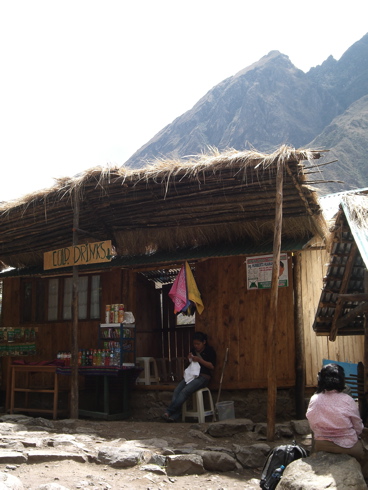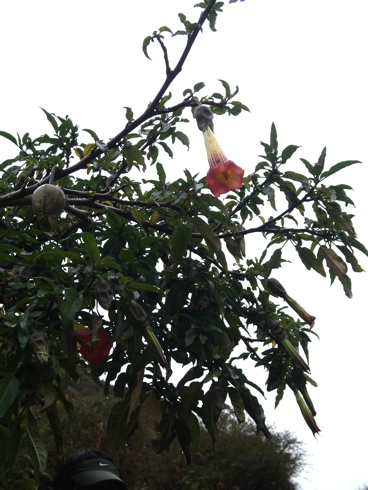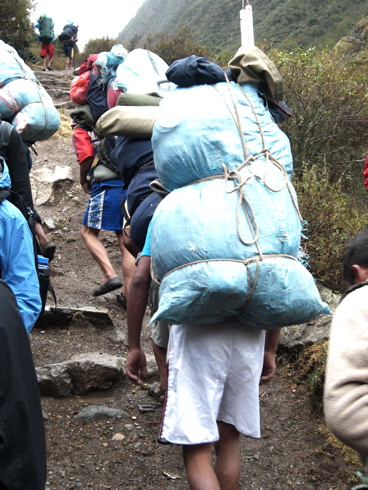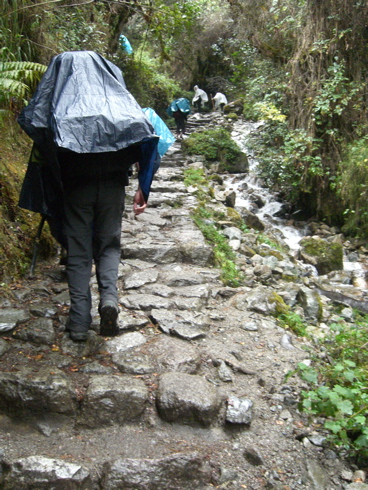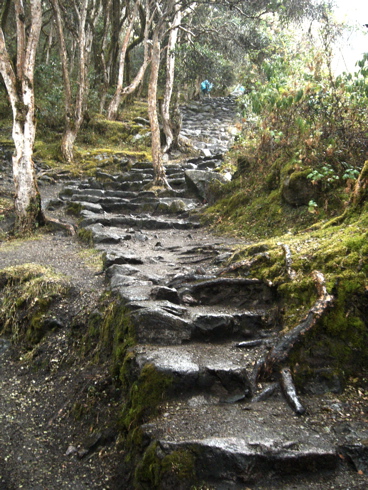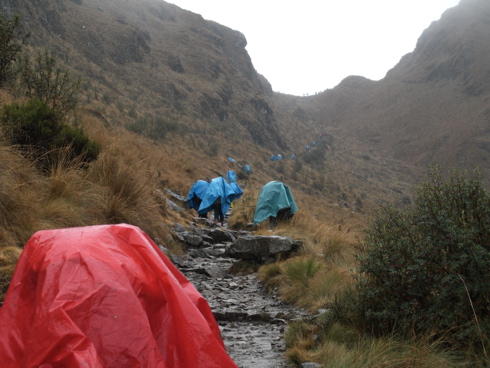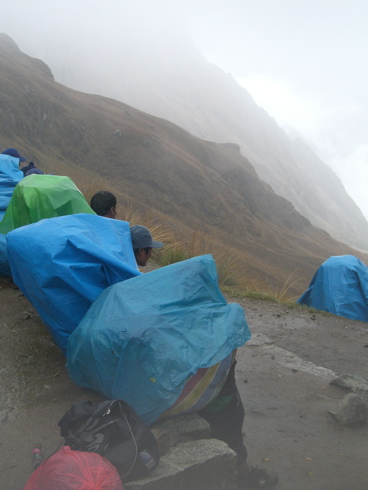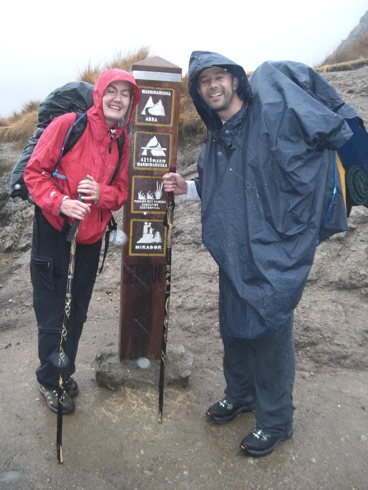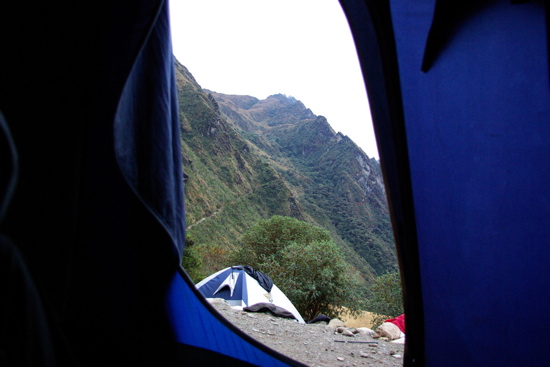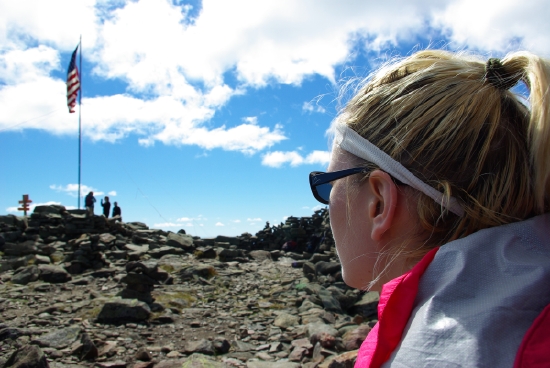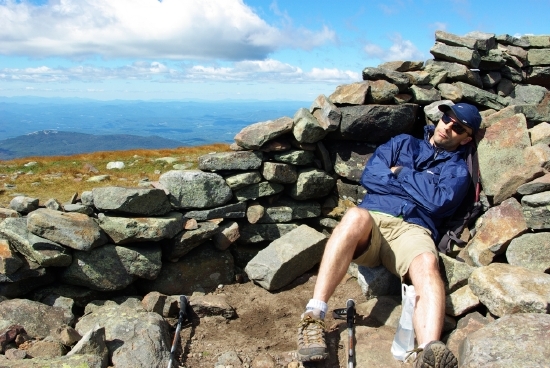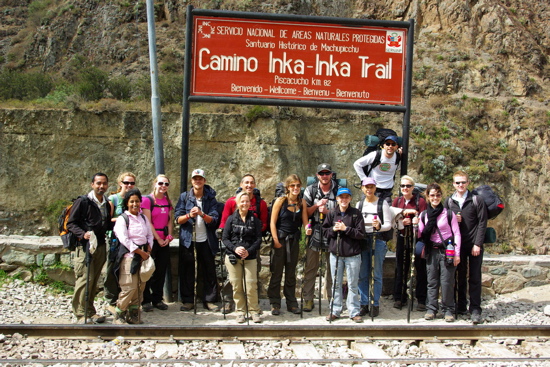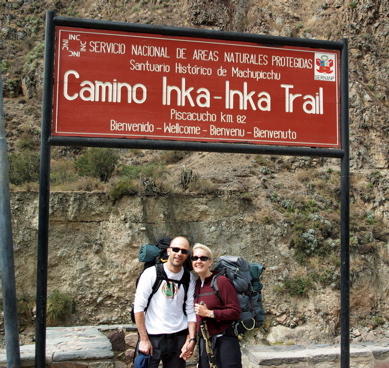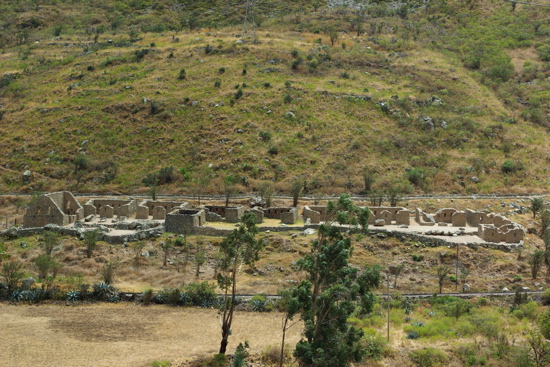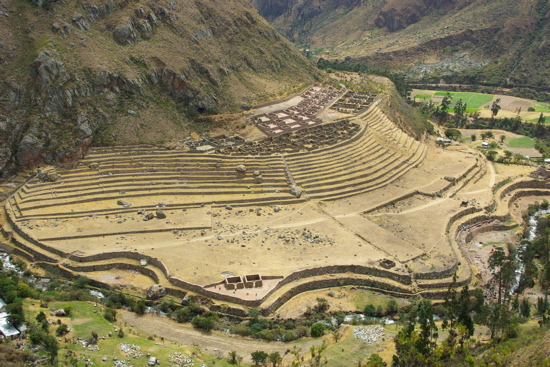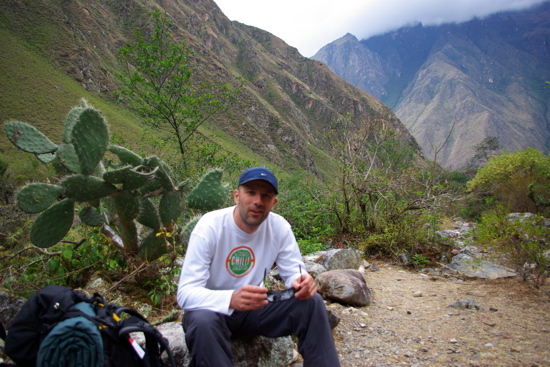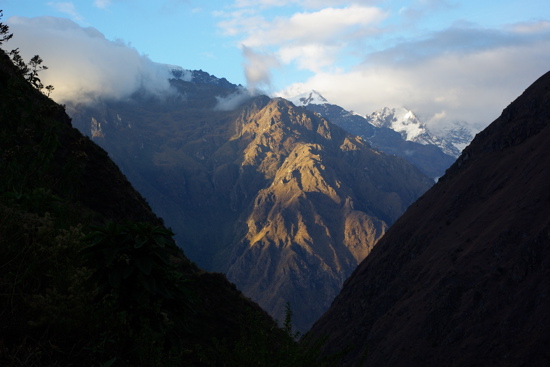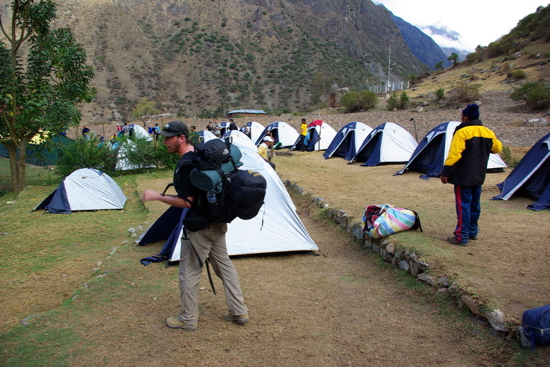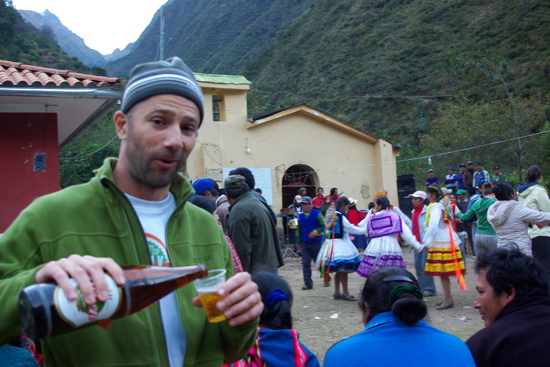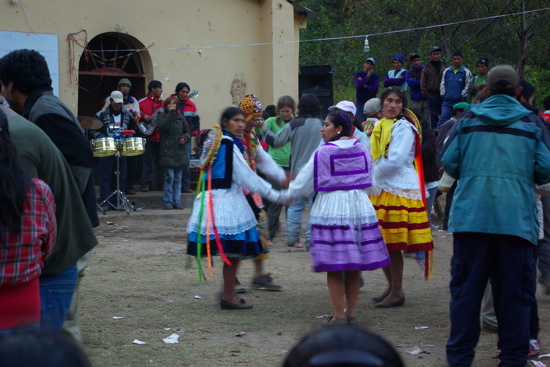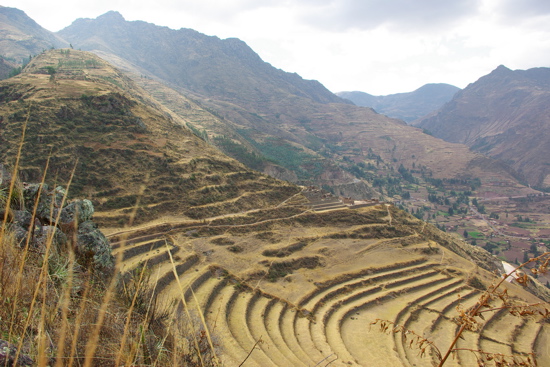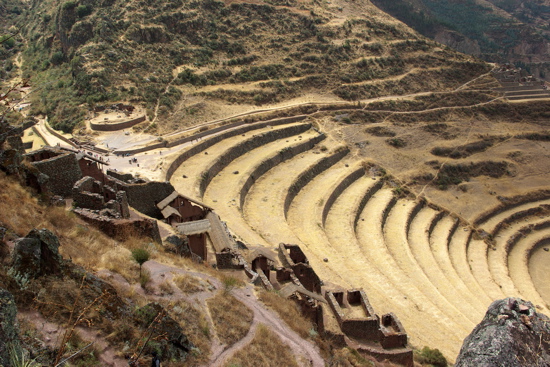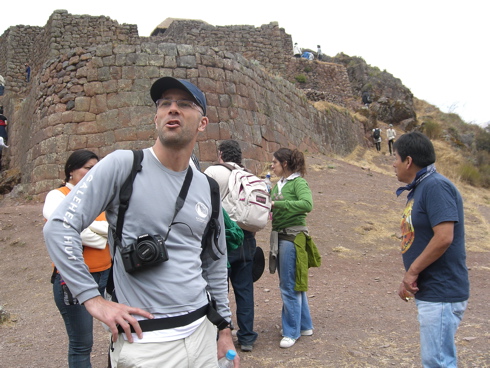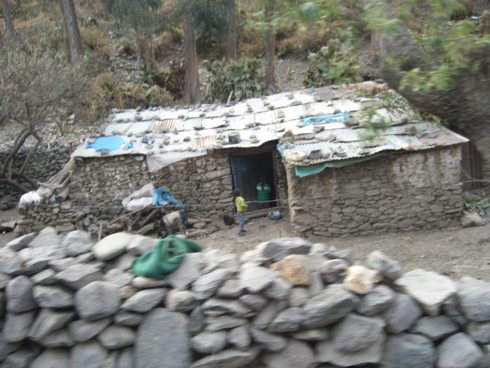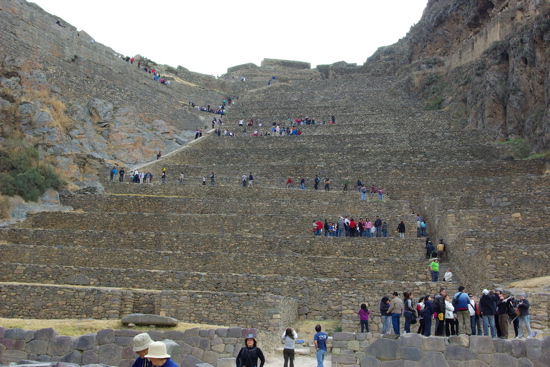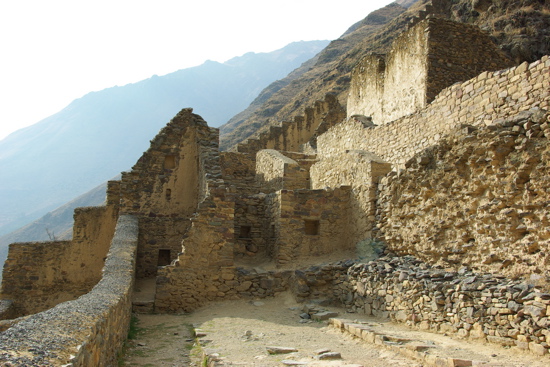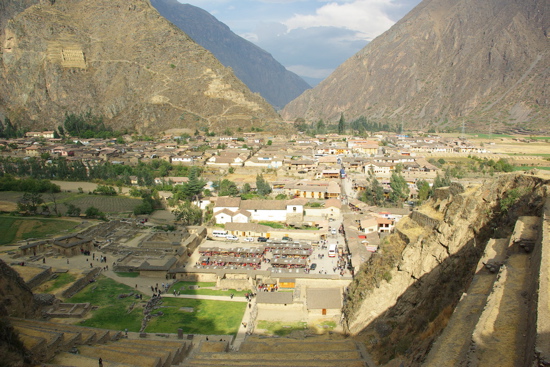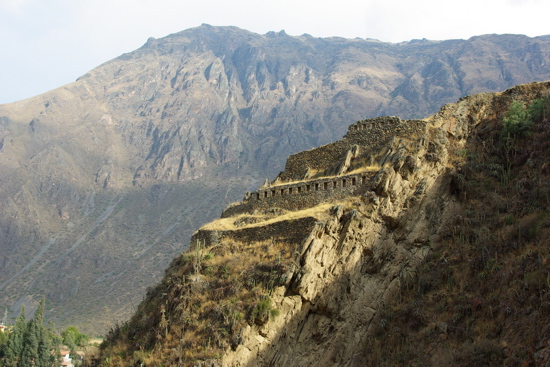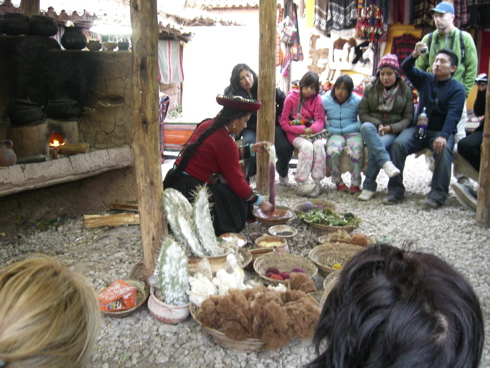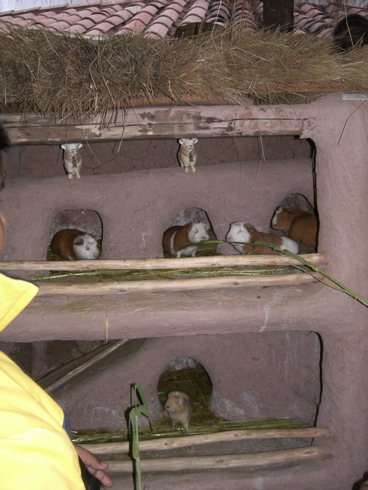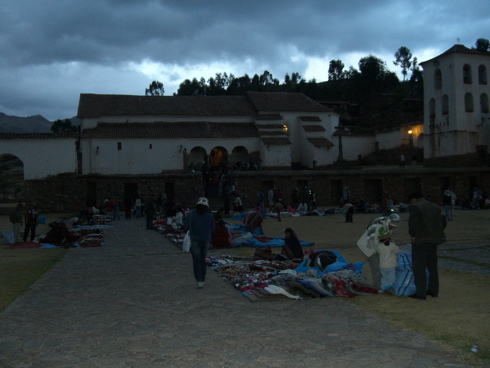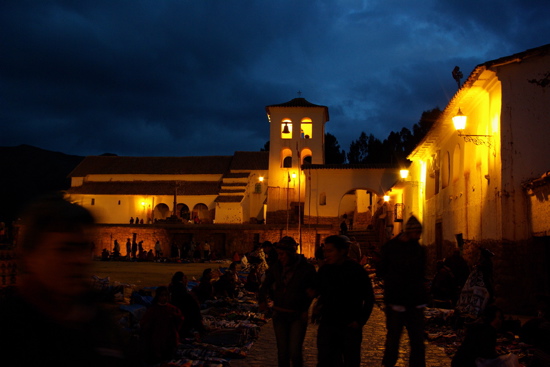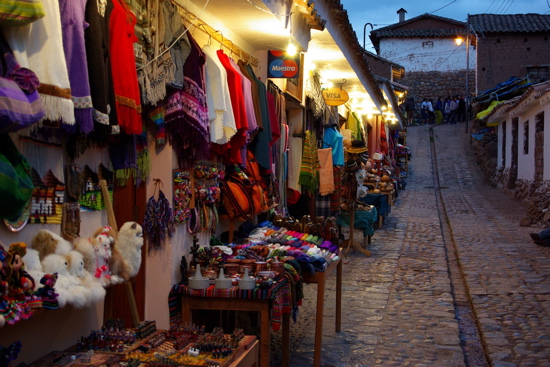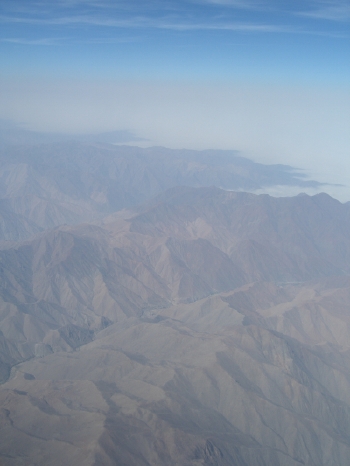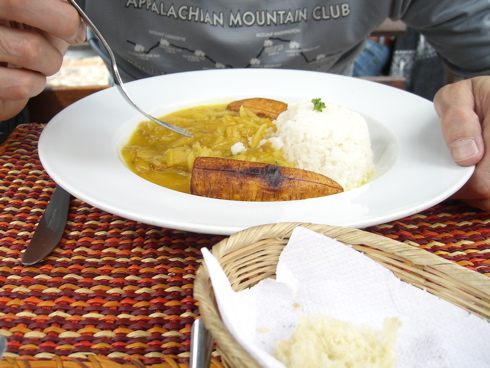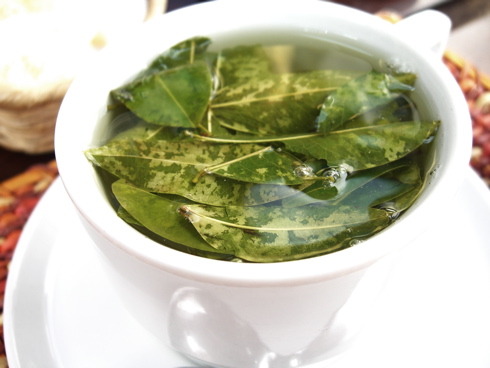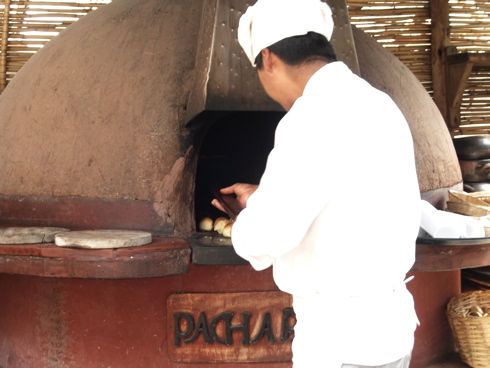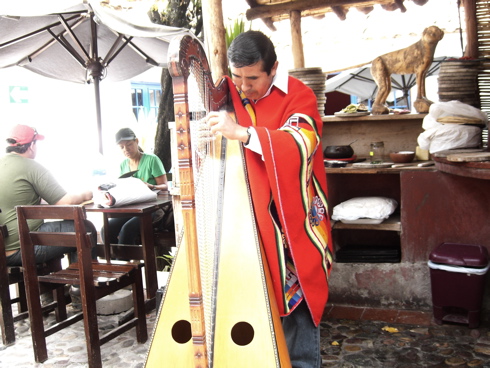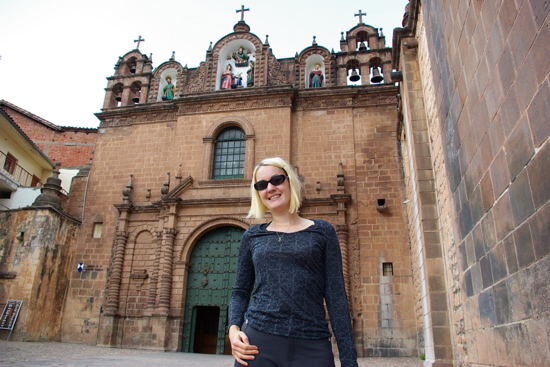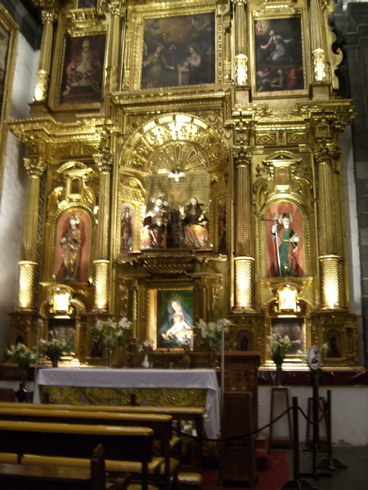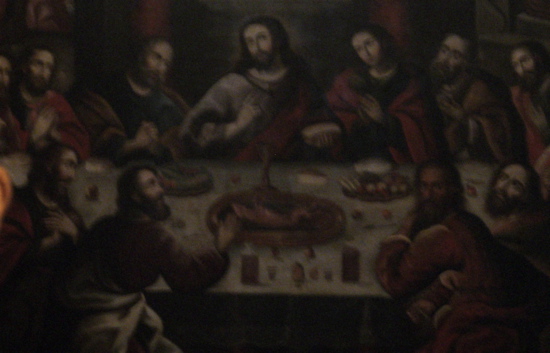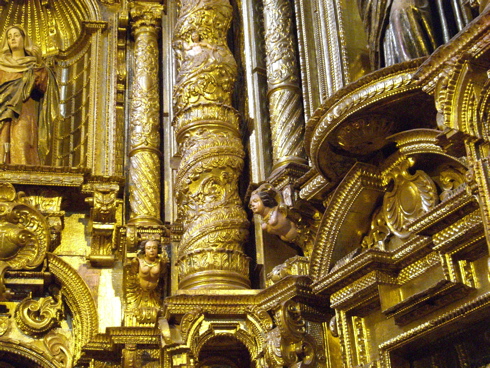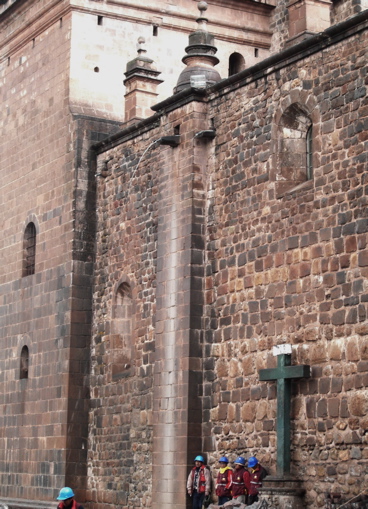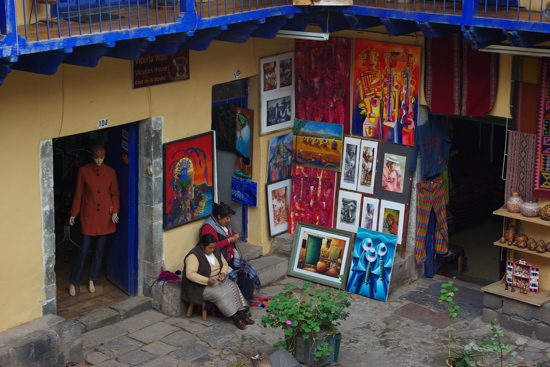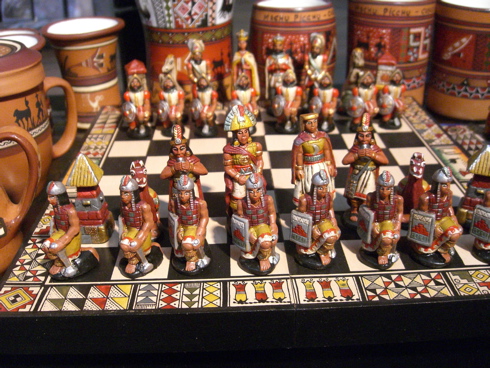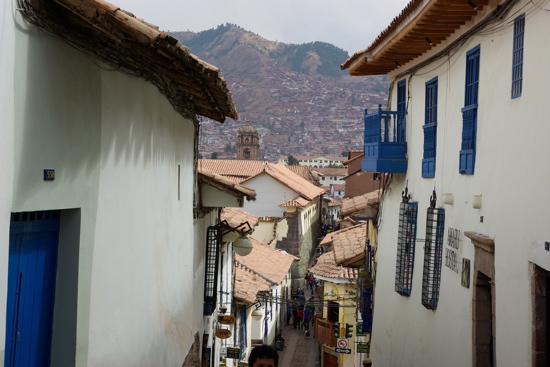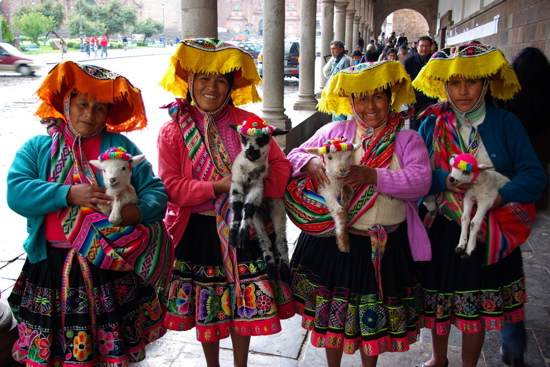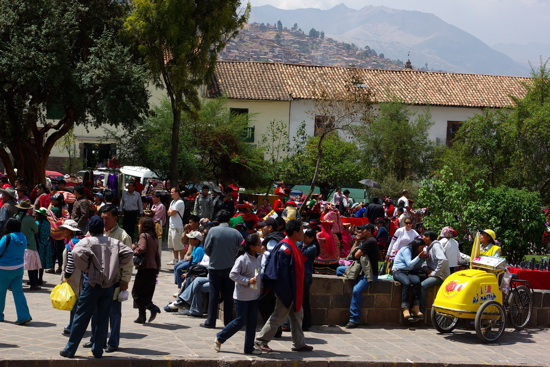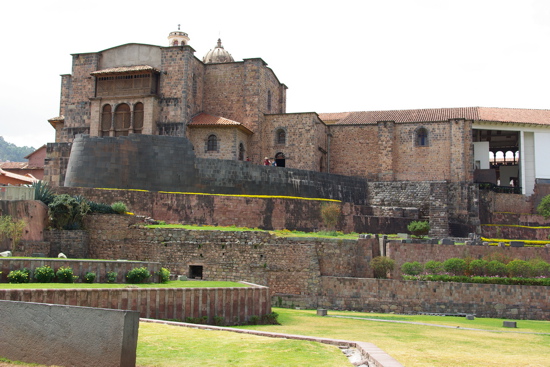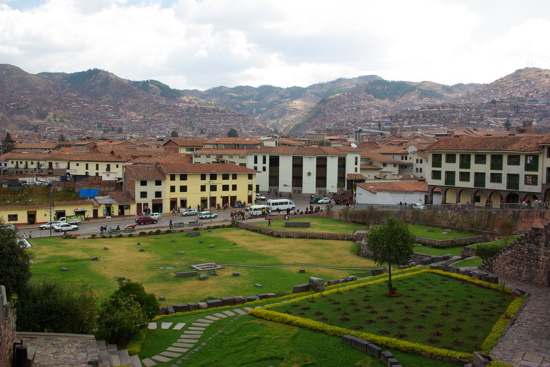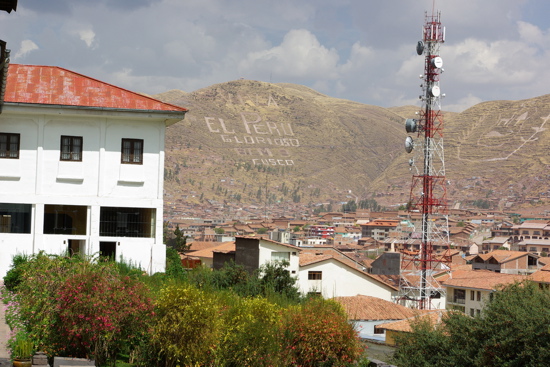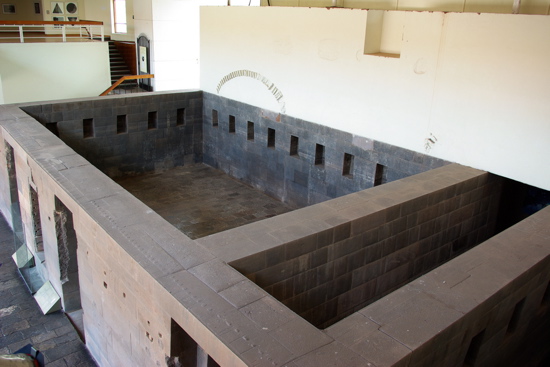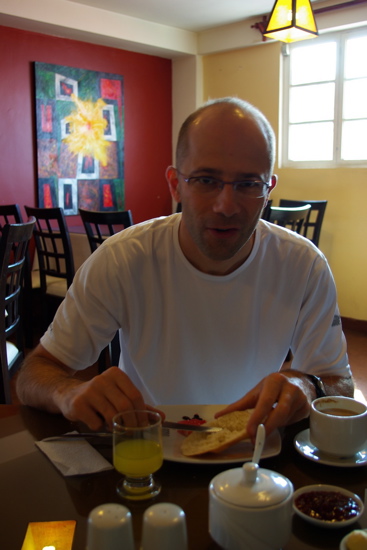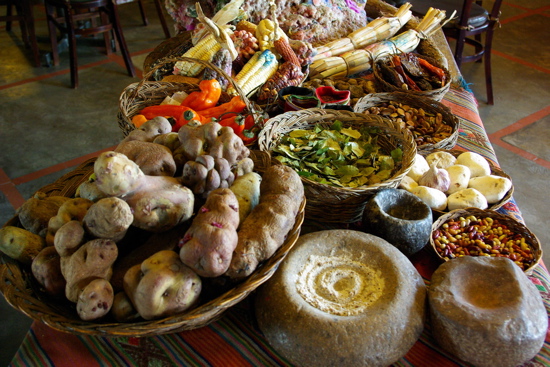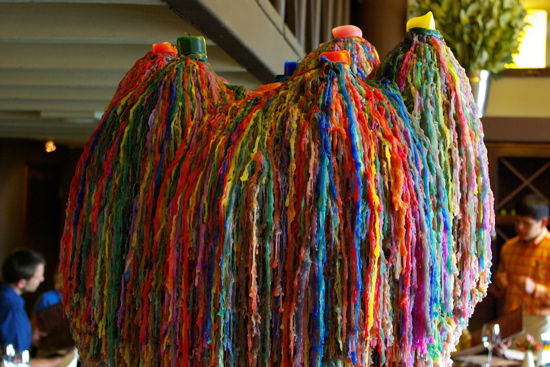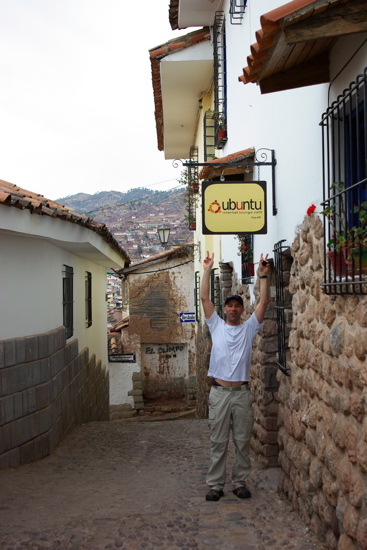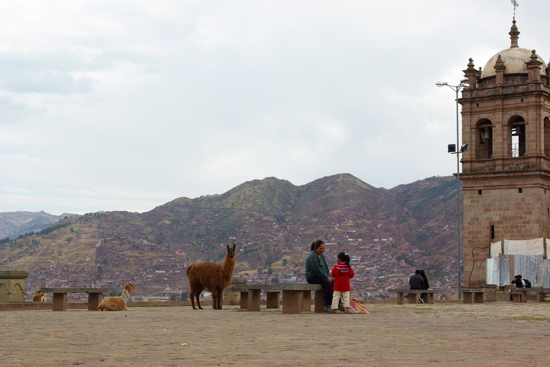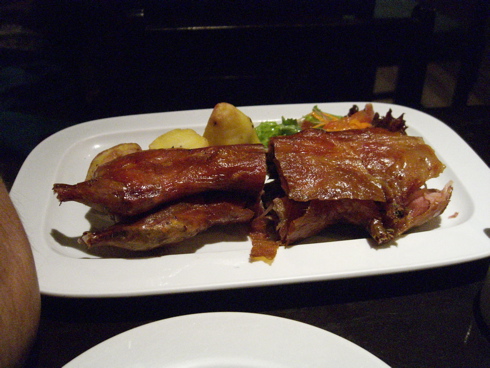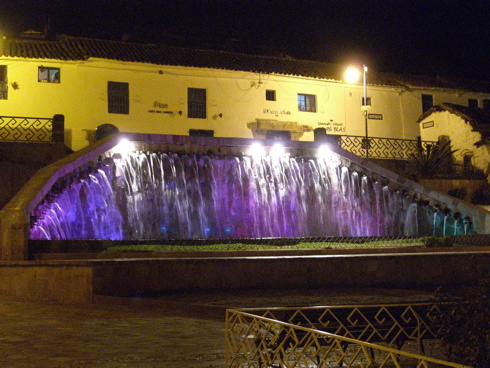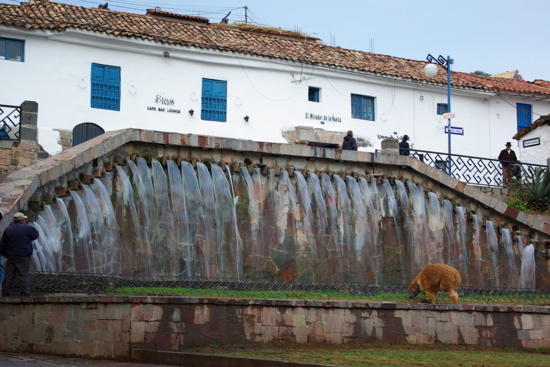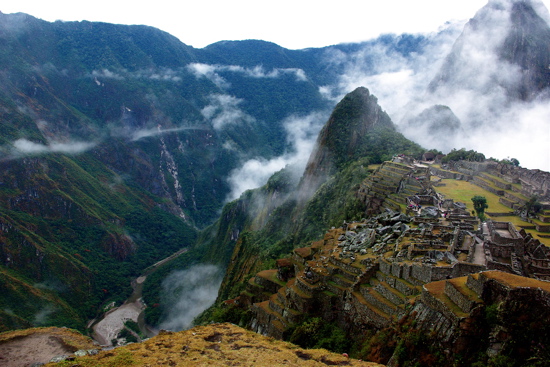My vexing insomnia continued into our final night on the Inca Trail. I did manage a few hours of fitful sleep before midnight, but subsequent to nothing my eyes were wide open and my mind active. Occasionally a light drizzle pattered on the roof of the tent, though the night was largely absent of downpours, giving me a glimmer of hope that the next day at Machu Picchu would be rain-free. Oh, I didn’t care about the clouds, the wind, the gray bleak sky. I didn’t even care about the past two days of relentless precipitation, so long as it’s not raining at Machu Picchu. I prayed to Pachamama, the only Incan deity I know by name, even though Pachamama is the Earth goddess and probably has little control over the weather.
Sometime over the course of the night, it occurred to me that my insomnia may have resulted from all the mate de coca tea that I had been drinking in order to stave off the shivers from wet clothes. Every time I turned around, there’s a porter with a tea kettle and a basket of coca leaves. Since I gave up coffee two years, I really don’t take much caffeine aside from the negligible amount in my daily green teas, but I was beginning to suspect that this mate de coca stuff was loaded with stimulants. I mean, this is the raw material for cocaine, I’m drinking six cups a day, and I wonder why I can’t sleep?
Whatever. The porters would come wake us up at 3:45am, but the Connecticut ladies in the adjacent tent set their alarm for 3:30am because they always need extra time in the morning. So I was up and putting in my contacts as weak groans emitted from Mr. P’s sleeping bag. “It’s Machu Picchu time!” I whispered/hissed. “This is your dream, right?”
Yes. You see, this whole trip — Cusco, the Inca Trail, Machu Picchu — was all Mr. P’s dream. I noticed that among the other couples in our group, there was always one person who championed the Inca Trail trip and one person who went along with it and now blamed their partner for the horrible hiking conditions that befell us. “We could’ve gone to Hawaii,” the Vancouver boyfriend moaned at the previous day’s lunch, as the tent shook and leaked on its soggy occupants. The Vancouver girlfriend hung her head and said, “I know, I know. Don’t worry, you’re picking our next vacation.” Strangely, I did not harbor such resentment towards Mr. P, because even though it rained, I still loved every minute of the trek. The rain was disappointing, but it’s not something anyone can control. I was determined to enjoy myself despite the weather, so Mr. P had damn better show equal determination.
The porters set up a small breakfast for us: Slices of untoasted bread, crepes, and hot beverages. It was 4am and no one was really hungry, but it would be a long day that would probably require carbs. After breakfast, our group grabbed our backpacks and walked about 5 minutes to the gate to Machu Picchu (not the main gate, but the “back-door” gate accessible only by the Inca Trail). It was 4:30am, one hour before it opened, and we were second in line behind a small group of Brits. Our place secured, most of the group headed off to the bathrooms. I lingered around, intially trying to make small talk with the unwilling Brits. (This group of horrible Brits — a posh mother with her two grown children — would wind up haunting Mr. P and I for the rest of our time in Peru.)
By 5:30am, there were probably about 200 people waiting to enter the gates to Machu Picchu. The horrible Brits were admitted promptly at 5:30am, and then our group followed. It was about a 90-minute walk from the gate to the famed Sun Gate, where Machu Picchu can be viewed with the sunrise. Our guide Will walked rapidly, more rapidly than ever before. We quickly passed the horrible Brits and kept our lead all the way to the Sun Gate, which we reached around 7am to find:
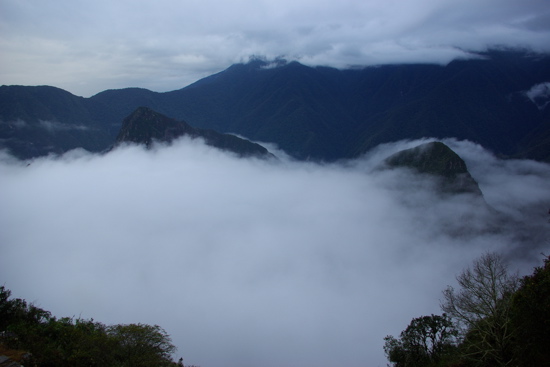
What Should Have Been Our First View of Machu Picchu from the Sun Gate
Though the rain had mercifully ceased, we still had clouds to contend with. Other groups filed into the Sun Gate, disappointed to find Machu Picchu totally obscured. We posed for a group photo anyway:
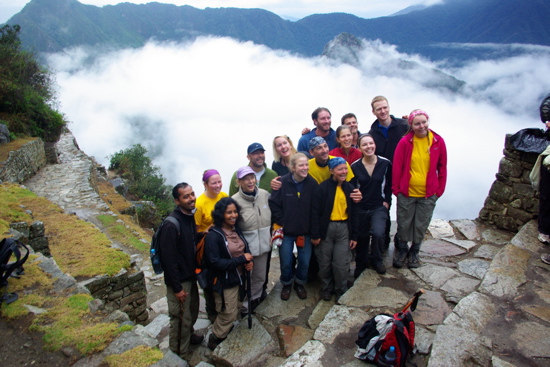
First Group at the Sun Gate
We pressed onward to get closer to Machu Picchu, and hopefully at an unblocked vantage point. 10 minutes later, we emerged on some ancient farming terraces to finally glimpse our prize:
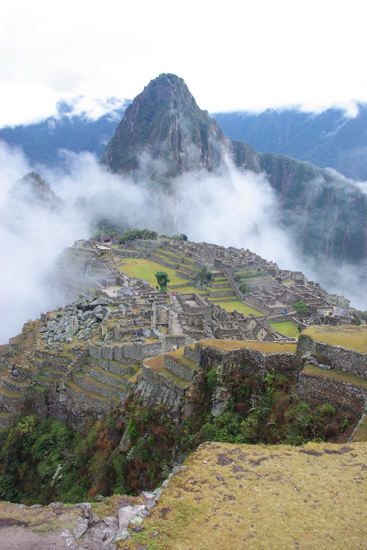
Machu Picchu
Holy mackerel. There it was, where it has always been, and it was magnificent. It was a city, vast and teetering on a precipice, stalwart yet crumbling, beautiful yet barren, swathed in cloud as if it wished to remain secluded.
Our joy was palatable. All the rain, all the shivers, all the sleepless nights faded to trifling matters that had happened in another lifetime.
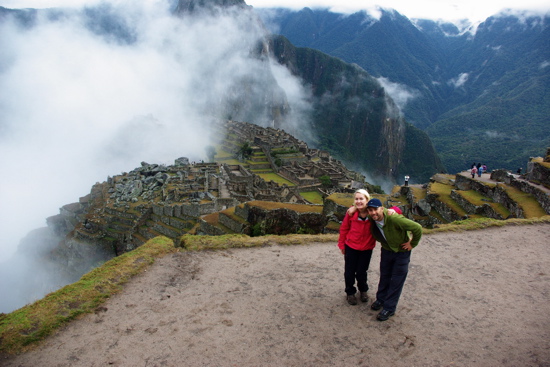
Machu Picchu
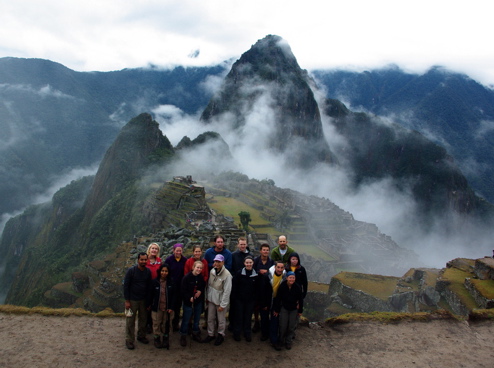
Group Photo at Machu Picchu
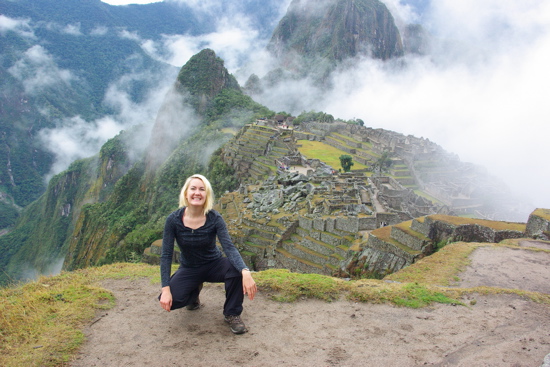
Machu Picchu
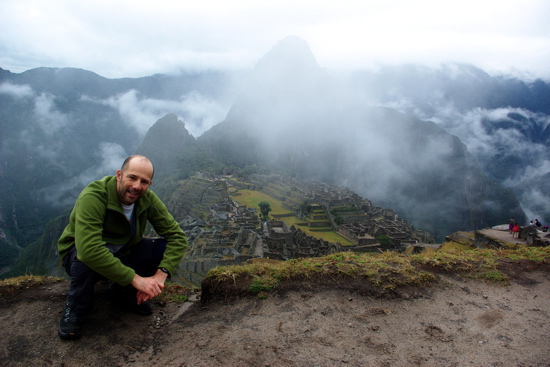
Machu Picchu
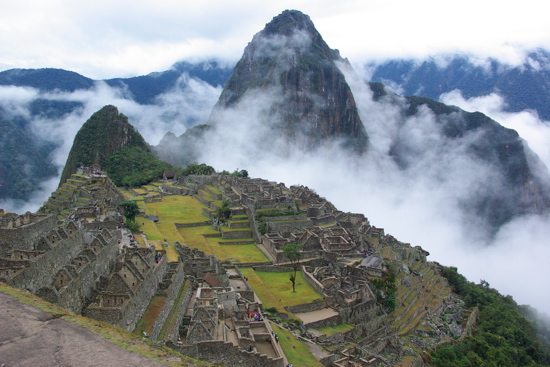
Machu Picchu
After our group got its fill of long-range photos, we descended down to the gates of Machu Picchu to use the restrooms, store our packs, and get our offical tickets. As we made our way down the trails, we began encountering day tourists who had come to Machu Picchu by way of train and bus. We were all immediately struck by how clean and nice they all looked. In comparison, we felt like swamp creatures.
Will the Guide took us for a tour of Machu Picchu. I won’t even try to narrate what we saw because it was all so overwheming that I can’t recall most of it.
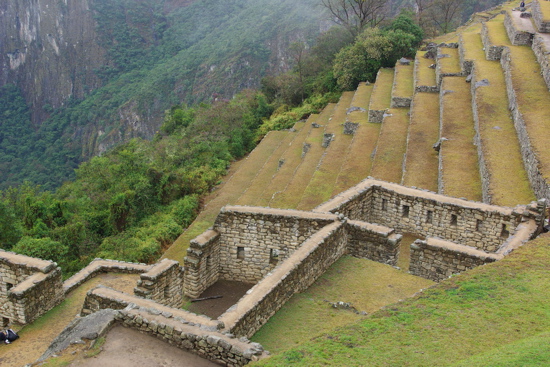
Machu Picchu Farming Terraces
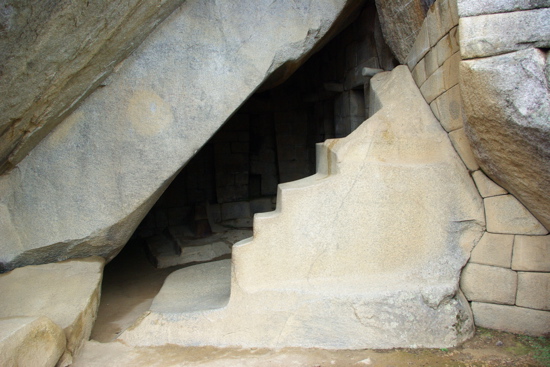
Machu Picchu — Temple of the Sun
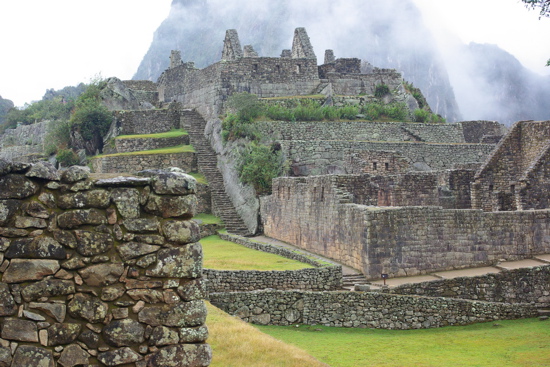
Machu Picchu
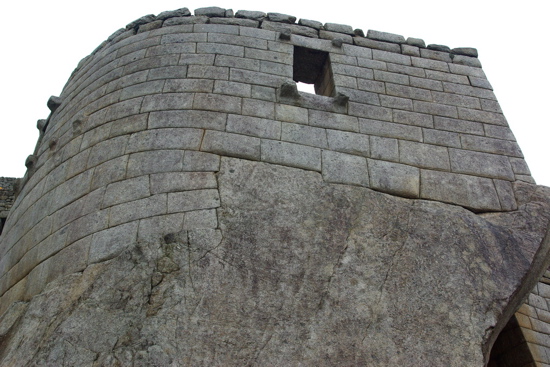
Machu Picchu — Temple of the Sun
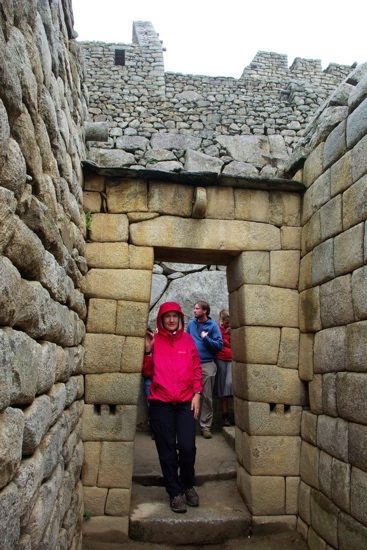
Machu Picchu
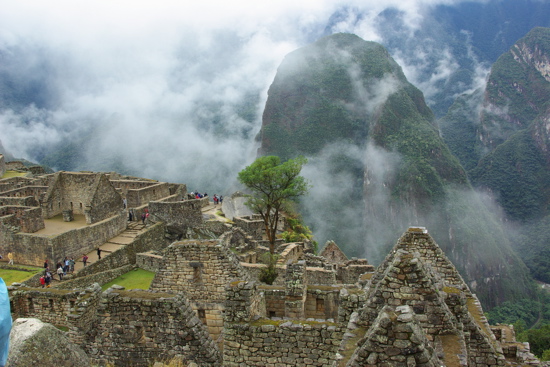
Machu Picchu
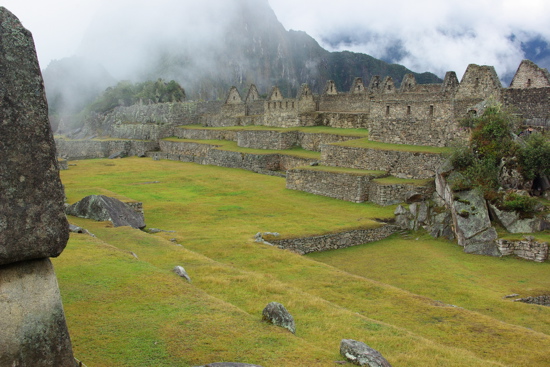
Machu Picchu
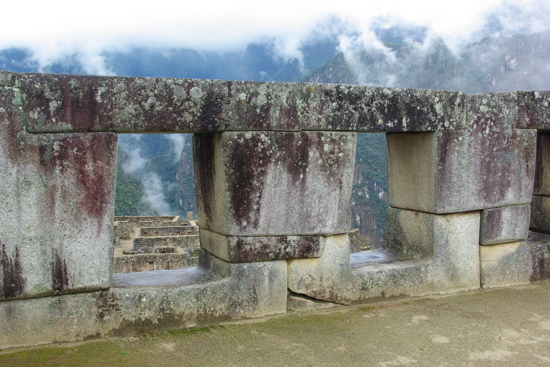
Machu Picchu
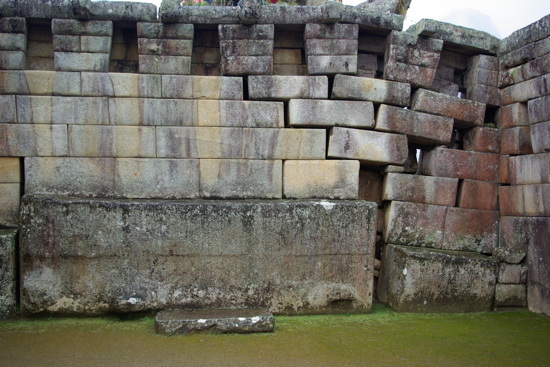
Machu Picchu
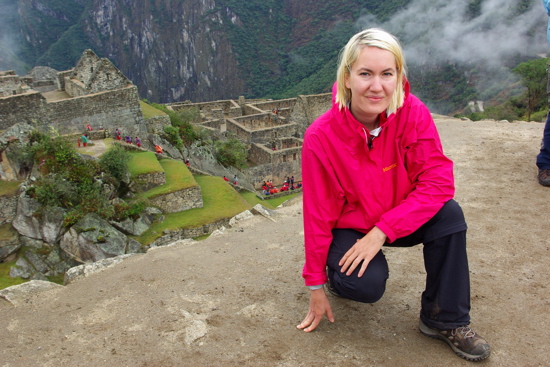
Machu Picchu
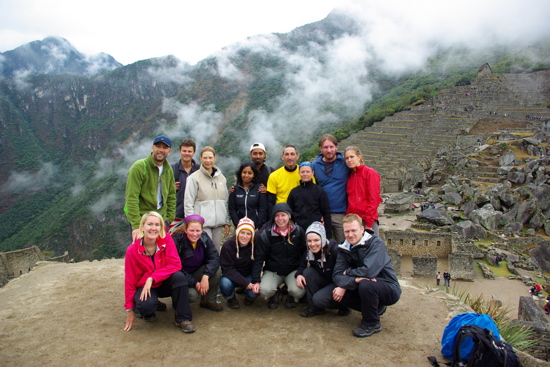
Machu Picchu — Last Group Photo
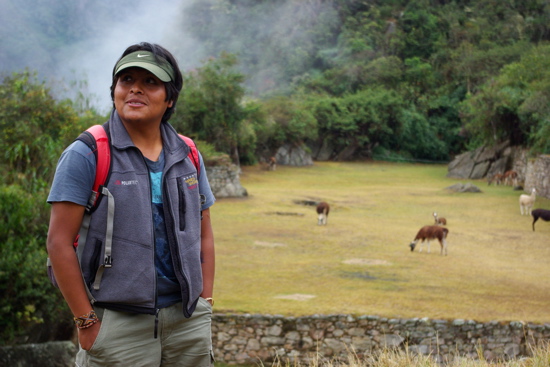
Will, Our Guide
After the last group photo, Will let us loose on Machu Picchu for a few hours, with explicit instructions on how to get to a restaurant in Aguas Caliente for our celebratory lunch. First, Mr. P and I mingled with some of our group near the grazing llamas.
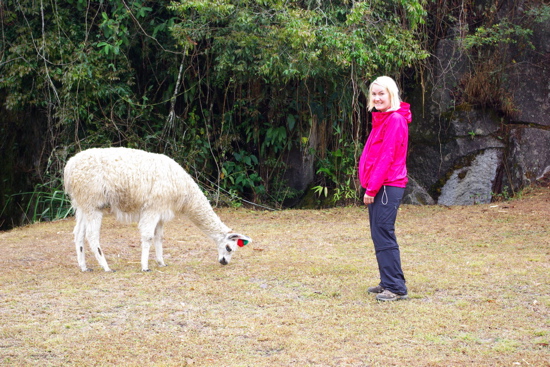
Llama
The nutty New Zealander decided to see if llamas could be mounted. It looks like he’s giving the llama a kick, but really, he just tried to jump on its back.
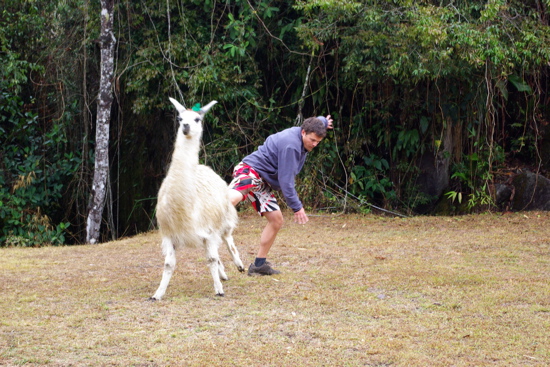
So Punk Rock
Someone yelled “Stop bothering them!” and we all exploded into laughter. Good times, with llamas!
At that point, Mr. P and I separated ourselves from the group so Mr. P could concentrate on taking pretty pictures.
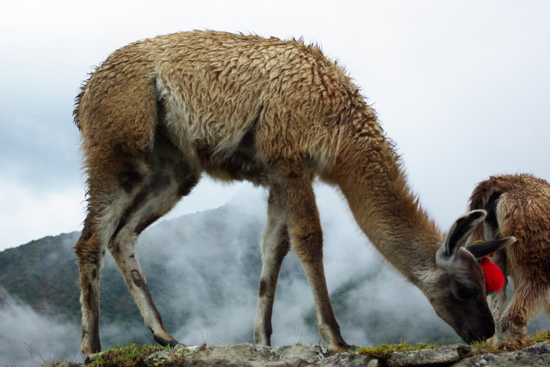
Machu Picchu Llama
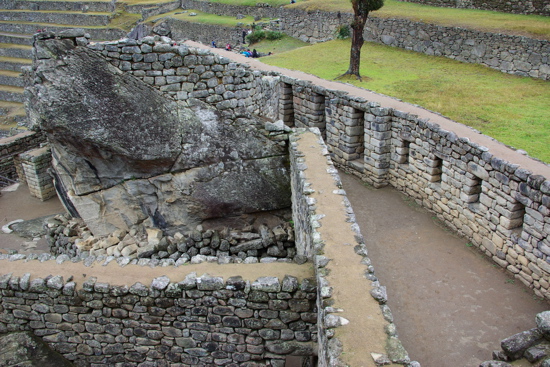
Temple of the Condor
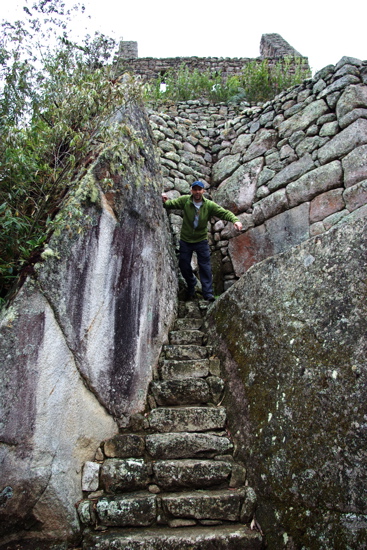
Machu Picchu
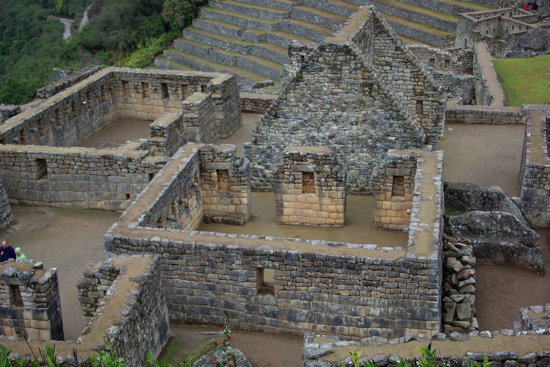
Machu Picchu
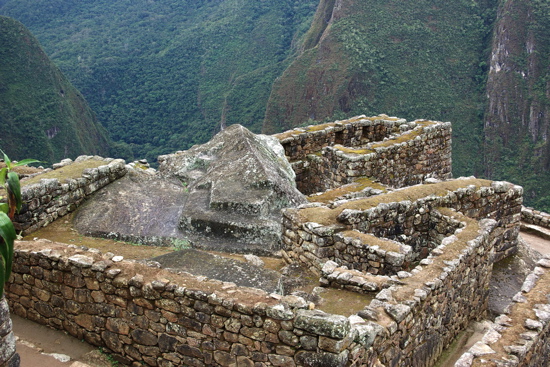
Machu Picchu
One thing that I loved about Machu Picchu is how the Incas intergrated nature into their architecture.
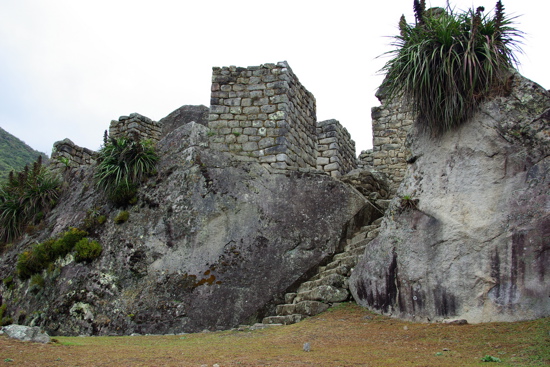
Machu Picchu
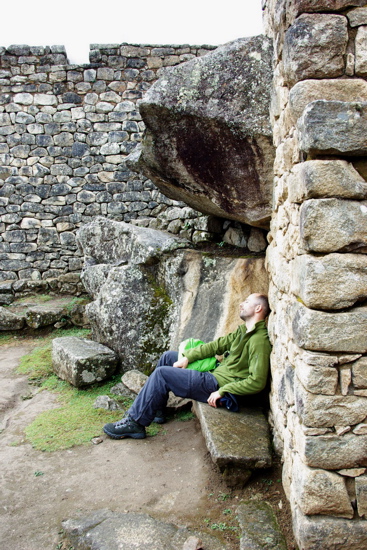
Machu Picchu
With about 45 minutes to go, we decided to go see the Inca Bridge. We met some members of our group coming back from it and they didn’t seem to impressed by the bridge, but we decided to go anyway.
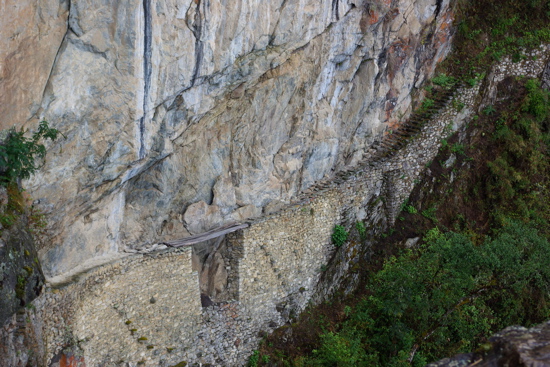
Inca Bridge at Machu Picchu
It was insanely steep and narrow. Jeepers. I refused to go near it, but Mr. P ventured on.
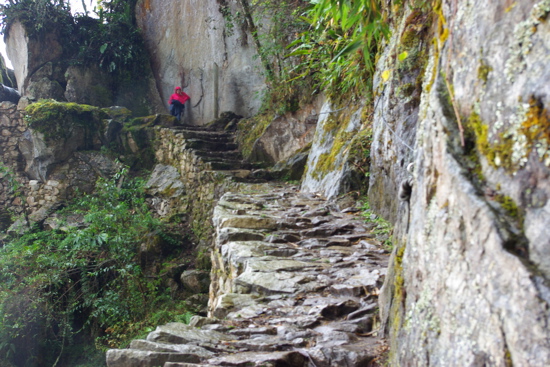
Inca Bridge
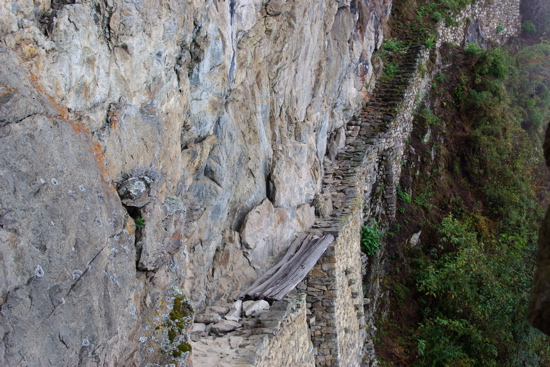
Inca Bridge
By then, we were sort of late for lunch. We left Machu Picchu and boarded the shuttle bus to Aguas Caliente, which took us down a winding road to the town. The rest of our group was already sitting down for lunch, except for the nutty New Zelander, who had decided to climb Wayna Picchu. He showed up 20 minutes later, bragging of his exploits even though he couldn’t see a thing from the top. We ordered pizza and beer, collected the tips for our guide and assistant guide, and elected the New Zealander to give a speech of appreciation. He stood up and began ranting incoherently about the rain. “What kind of a speech is this?” I whispered to one of the Brits. “Exactly the kind of speech we knew he’d give!” she whispered back.
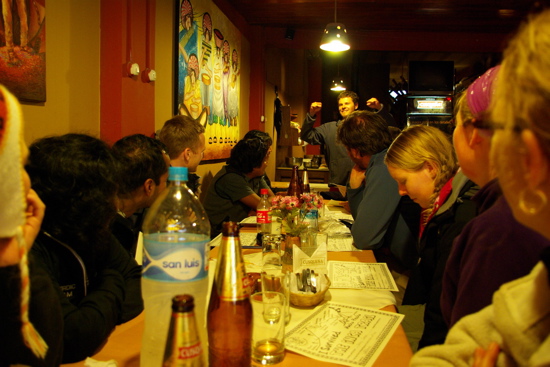
Speech!
After lunch, some people in our group decided to take the early train back to Cusco, while the rest of us went to the famed hot springs of Aguas Caliente to unwind in the pools for a few hours. This was my favorite part of the whole trek — bobbing around the hot water, laughing with everyone about our misadventures, and watching the sun light up the early evening skies. Fucking sun!
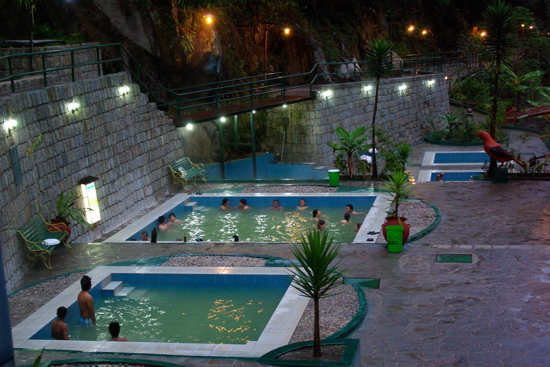
At Aguas Caliente
Regrettably, it was then time to return to Cusco. We met our guide back at the restaurant, grabbed our packs, and headed for the “backpacker” train back to Ollantaytambo. From there, we boarded a private bus back to Cusco. Within 5 minutes of getting on the bus, I fell asleep. Deeply asleep. Apparently the bus driver was driving like a maniac and everyone was laughing and talking, yet I slept profoundly. When I woke up, we were in Cusco and it was time to go back to our hotel. We hugged our goodbyes and hiked briskly uphill to our hotel. Where, again, I slept like the dead.
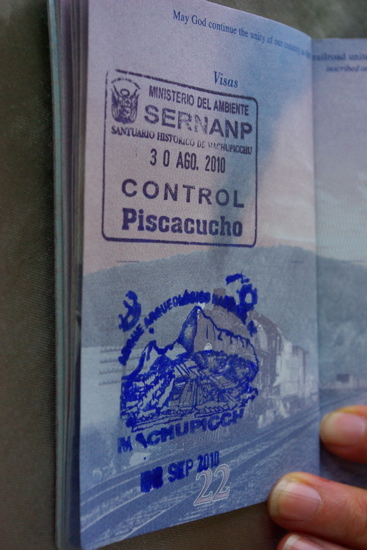
Machu Picchu Passport Stamps
